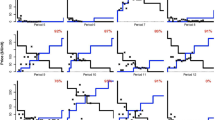Abstract
A sequential auction of commercial properties produced evidence that bid timing matters. Prices declined as the auction proceeded, an outcome consistent with expectations when bidders are either risk averse or quantity constrained.
Similar content being viewed by others
References
Abowd, J., and O. Ashenfelter. (1988). “Art Auctions: Price Indexes and Sale Rates for Impressionist Pictures,” unpublished.
Ashenfelter, O. (1989). “How Auctions Work for Wine and Art,”Journal of Economic Perspectives Vol. 3, Summer, 23–36.
Ashenfelter, O., and D. Genesove. (1992). “Testing for Price Anomalies in Real Estate Auctions,”American Economic Review May, 501–505.
Burns, P. (1985a). “Experience and Decision Making: A Comparison of Students and Businessmen in a Simulated Progressive Auction,”Research in Experimental Economics Vol. 3, Greenwich, Connecticut: JAI Press.
Burns, P. (1985b). “Market Structure and Buyer Behavior: Price Adjustment in a Multi-Object Progressive Oral Auction,”Journal of Economic Behavior and Organization 6, 275–300.
De Boer, L., J. Conrad, and K. McNamara. (1992). “Property Tax Auction Sales,”Land Economics February, 72–82.
Gau, G., D. Quan, and T. Sternberg. (1991). “The Performance of Real Estate Auctions: A Case Study,” Working Paper, University of Texas, Austin.
Heckman, J. (1979). “Sample Selection Bias as a Specification Error,”Econometrika 47, 153–161.
Krueger, A., and L. Summers. (1988). “Efficiency Wages and the Inter-Industry Wage Structure,”Econometrica March, 259–294.
Maher, C. “Information, Intermediaries and Sale Strategy in an Urban Housing Market: The Speculation of Real Estate Auctions in Melbourne,”Urban Studies October, 495–509.
Mayer, C. (1992). “Assessing the Performance of Real Estate Auctions,” Working Paper, MIT.
McAfee, R., and J. McMillan. (1986). “Bidding for Contracts: A Princpal-Agent Analysis,”Rand Journal of Economics Autumn, 326–338.
McAfee, R., and D. Vincent. (1991). “The Afternoon Effect,” Working Paper, University of Texas, Austin.
Vanderporten, B. (1992). “Strategic Behavior in Pooled Condominium Auctions,”Journal of Urban Economics January, 123–137.
Vickrey, W. (1961). “Counterspeculation, Auctions and Competitive Sealed Tenders,”Journal of Finance March, 8–37.
White, H. (1980). “A Heteroskedasticity-Consistent Covariance Matrix Estimator and a Direct Test for Heteroskedasticity,”Econometrica Vol. 48, 817–838.
Wilson, R. (1992). “Strategic Analysis of Auctions.” In theHandbook of Game Theory, (eds.), R. Aumann and S. Hart. Amsterdam: North Holland.
Author information
Authors and Affiliations
Rights and permissions
About this article
Cite this article
Lusht, K.M. Order and price in a sequential auction. J Real Estate Finan Econ 8, 259–266 (1994). https://doi.org/10.1007/BF01096996
Issue Date:
DOI: https://doi.org/10.1007/BF01096996




